An NIH Research Dynasty in Building 3
A Who’s Who of Biomedical Researchers
NIH’s Building 3 was once a researcher’s paradise. For more than half a century, it was chock-full of remarkable scientists and bustling with activity. Before it closed in 2001, it had housed some of NIH’s best biomedical investigators—pioneering malaria researchers, the first female board-certified heart surgeon, a fledging leader of the pharmaceutical industry, three future NIH directors, 15 scientists who were inducted into the National Academy of Sciences, and five eventual Nobel laureates.
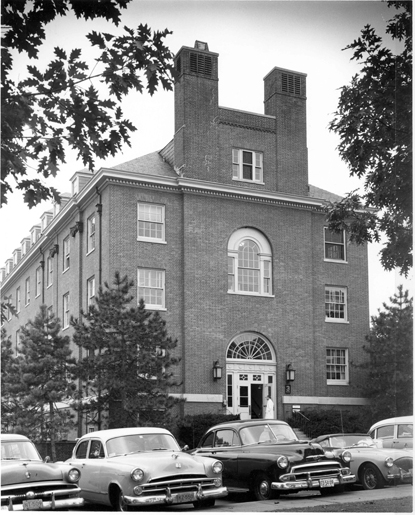
Courtesy: NIH OFFICE OF HISTORY
NIH’s Building 3, a hotbed of research until it was closed in 2001, was home to pioneering malaria researchers, the first female heart surgeon, three future NIH directors, five eventual Nobel laureates, and cars that could plow through a brick wall. (Photo circa 1950)
The historic building sat vacant for almost 10 years before extensive renovations began to transform it into the office building it is today. The outside, down to the landscaping, looks almost the same as it did in 1938. Even the trees are the same: Workers were careful to preserve the root systems. But inside, the interior walls, elevators, stairs, restrooms, and mechanical, electrical, and telecommunication distribution systems were torn down and replaced. In March 2012, dozens of administrative staff members from six institutes (NIAID, NHLBI, NIDDK, NCI, NINR, and NIMHD) began moving in.
But listen carefully and you can almost hear the ghosts of the amazing people who once worked there.
Building 3 was built by the George Fuller Company of Bethesda in 1938 and is part of NIH’s historic core of Georgian Revival Buildings along with Buildings 1,2,4,5, and 6. First designated the Public Health Methods and Animal Unit Building, each floor featured a central corridor with laboratories, offices, and shared laboratory support space on either side; facilities for animal breeding were in the attic. The building’s early occupants included researchers from the National Microbiological Institute (NMI), which became the National Institute of Allergy and Infectious Diseases (NIAID) in 1955; the Experimental Biology and Medicine Institute, which in 1950 became the National Institute of Arthritis and Metabolic Diseases (NIAMD), the forebear of the current National Institute of Diabetes and Digestive and Kidney Diseases (NIDDK) and the National Institute of Arthritis and Musculoskeletal and Skin Disease (NIAMS); and the National Heart Institute (NHI), now the National Heart, Lung, and Blood Institute (NHLBI).
During World War II, NIH research focused almost entirely on war-related problems including developing treatments for malaria and other tropical diseases. G. Robert Coatney, who in 1937 identified the malaria parasite in birds, set up a program at NIH’s Washington, D.C., campus in 1938 to test potential antimalarial compounds in animals. He moved his lab to Building 3 in 1943. His research team tested the effectiveness of more than 2,000 compounds against infections caused by the avian parasite Plasmodium gallinaceum in young chicks. In 1960, he became chief of NIAID’s Laboratory of Parasite Chemotherapy.
Another Building 3 inhabitant in the 1940s was Nathan B. Eddy, a trailblazer in the field of drug dependence. He worked with NIH chemist Lyndon F. Small (who sought to create nonaddicting painkillers) to evaluate compounds for their painkilling effectiveness and potential to be addictive. Later work with another NIH chemist, Everette May, led to the development of synthetic opioids, such as the 1960s drug pentazocine, that relieved pain without the potential for abuse.
In 1947, future Nobel Laureate Arthur Kornberg launched NIAMD’s newly formed Enzyme and Metabolism section in Building 3. Noteworthy members of his laboratory included Bernard Horecker and Leon Heppel. Horecker is best known for his contributions to the pentose phosphate pathway, the end products of which are needed for amino and fatty acid synthesis. Heppel was a leader in the study of enzymes that modify RNA.
Herbert Tabor, who worked in another building, would join Kornberg, Horecker, and Heppel in Building 3 for weekly lunch seminars on enzymology. “We did, in a rather intensive way, every week including most holidays, have a three-quarters of one hour presentation on all the important topics in biochemistry,” said Tabor, now a senior investigator in the Pharmacology Section in NIDDK. “It was particularly helpful to me–Kornberg and I only had M.D.s. Essentially, we learned biochemistry.”
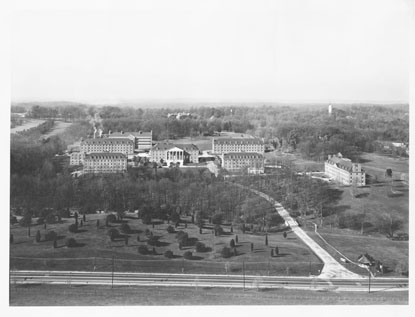
COURTESY OF NIH OFFICE OF HISTORY
The NIH campus in the 1940s included the historic core of six Georgian-style buildings, built in the late 1930s, and Buildings 7, 8, and 9, constructed in the 1940s. In keeping with the tradition of the random location of buildings, Building 1 (with the columns) is in the center; to the left, from front to back, are buildings 3, 8 (partially hidden), 5, 9 (partially hidden), and 7; to the right, from front to back, are buildings 6 (in the foreground), 2, and 4.
Kornberg left NIH to head the Microbiology Department at Washington University School of Medicine (St. Louis) in 1953 and then moved to Stanford University (Stanford, Calif.). In 1959, he shared the Nobel Prize in Physiology or Medicine for the discovery of the mechanisms in the biological synthesis of RNA and DNA.
NHLBI was born in 1948 in Building 3, although at the time it was simply the National Heart Institute. In 1949, James A. Shannon—who had been a leader of New York University’s Research Service at Goldwater Memorial Hospital on Welfare Island in New York and directed its antimalarial research group—was appointed NHI’s first director of intramural research. Shannon, from his office on Building 3’s second floor, recruited members to fill research positions in areas such as cell biology, chemical pharmacology, cardiovascular physiology, kidney and electrolyte metabolism, natural products chemistry, technical development, and cardiovascular surgery. He moved to Building 1 in 1952, where he served first as the director of intramural research for all of NIH and then as NIH director (1955–1968). He oversaw a period of increased construction, additional funding for research personnel and laboratories, and the creation of new research centers. He brought money from Capitol Hill and new optimism to NIH. To honor him for his many contributions, the central administration building (Building 1) was named for him in 1983.
Notable recruits from Shannon’s former group at Goldwater Hospital were Bernard B. Brodie, Robert Berliner, Robert Bowman, and Sidney Udenfriend. Brodie was brought in as head of NHI’s Laboratory for Clinical Pharmacology and later received a 1967 Lasker Award for his contributions to biochemical pharmacology. Berliner, an eminent renal physiologist, was appointed chief of the Laboratory of Kidney and Electrolyte Metabolism, served as director of intramural research of the National Heart Institute (1954–1968), and was appointed NIH deputy director for science 1969-1973). He left in 1973 to become dean of the Yale School of Medicine (New Haven, Conn.).
Bowman became chief of the Laboratory of Technical Development and invented the practical spectrophotofluorometer (SPF), an instrument originally designed to measure the concentration of antimalarial drugs. Udenfriend and Brodie helped Bowman develop the SPF. Udenfriend left NIH in 1967 to become the founding director of the Roche Institute of Molecular Biology (Nutley, N.J.).
Brodie recruited former Goldwater colleague Julius Axelrod as a technician who later went to graduate school at George Washington University School of Medicine (Washington, D.C.). Axelrod shared the 1970 Nobel Prize in Physiology or Medicine for work on the release and reuptake of catecholamine neurotransmitters.
Axelrod was taken with the research environment in Building 3. “It was a remarkable place,” he said in a 1991 NIH Alumni Association Update article. “We were all young, and working in a very charged atmosphere.”
In 1953, Shannon also hired 10 young physicians as clinical research associates to split their time between working in NIH’s new Clinical Center, taking care of patients, and in the laboratory. Two physicians to go through this program, and who spent their first several months at NIH in Building 3 labs, later became NIH directors: James Wyngaarden and Donald S. Fredrickson.
Another Shannon recruit to later receive the Nobel Prize was Christian Anfinsen, who was appointed chief of NHI’s Laboratory of Cellular Physiology in 1950. Anfinsen shared the 1972 Nobel Prize in Chemistry for groundbreaking work in protein chemistry. Two of Anfinsen’s postdoctoral fellows who worked in his Building 3 laboratory are still at NIH—Edward Korn and Martha Vaughan—and they remember some of the building’s quirks.
Researchers often shared the Building 3 elevator with animals being transported to the top floor. “I once got in the elevator with a cow going up, who was urinating at the time,” chuckled Korn, now chief of NHLBI’s Laboratory of Cell Biology. “I was sort of ankle deep.”
Vaughan, now chief of NHLBI’s Laboratory of Metabolic Regulation, recalls the cumbersome ventilation system. Her lab’s air conditioner was a window unit positioned over a vent for a chemical fume hood in a basement laboratory. “When anybody used the chemical hood downstairs to carry away the noxious fumes, they would let us know,” said Vaughan. The warning alerted Vaughn to turn off the air conditioner, which would have sucked the fumes into her lab.
In 1950, Anfinsen recruited biochemists: Thressa Stadtman—who had been his research assistant at Harvard Medical School (Boston)—and her husband Earl. The Stadtmans became outstanding researchers and beloved mentors to later generations of NIH scientists. They remained in Building 3 until its 2001 closing, except for several years in the mid-1950s when they worked at the Clinical Center. Initially, Earl Stadtman was disappointed that his labs weren’t ready when he arrived at NIH. “The laboratories in the basement of this building at that time were just a gaping hole,” he said in a 2001 interview with NIH’s Office of History. Fortunately, Arthur Kornberg offered the group the temporary use of a vacant laboratory on the first floor.
Thressa Stadtman studied the bacterial degradation of cholesterol, while Earl Stadtman researched fatty acid metabolism. Earl was appointed chief of NHLBI’s Laboratory of Biochemistry in 1962, and Thressa became one of its section heads in 1974.
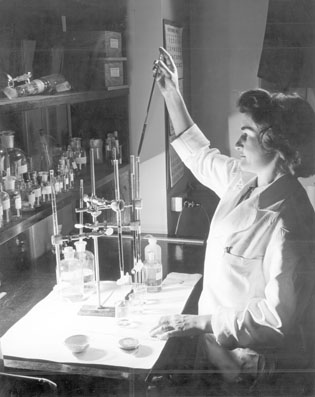
COURTESY OF NIH OFFICE OF HISTORY
Thressa (shown) and Earl Stadtman worked in Building 3 and were outstanding biochemists and mentors who dedicated their careers to research at NIH.
The Stadtmans made several landmark contributions to the field of biochemistry, switching their research focus as they saw fit. In the late 1950s, Thressa’s studies of anaerobic metabolism systems led to the discovery of five of the 12 known vitamin B12–dependent enzymes. She also pioneered the field of selenium biochemistry, identifying many selenium-containing proteins. Selenium has been shown to have health benefits in animal studies and may be a necessary nutrient for humans.
Earl’s initial work in Building 3 helped to establish the role of coenzyme A in the synthesis of fatty acids. In the 1960s and 1970s, he and co-workers identified mechanisms for controlling the production of amino acids. In the 1980s, his team began investigating protein damage in relation to aging and found that the accumulation of damaged proteins may play a role in age-related disorders such as Parkinson disease.
Between them, the Stadtmans trained more than 100 postdoctoral fellows, including Roy Vagelos, Michael Brown, and Stanley Prusiner. Vagelos started as a clinical fellow in Earl’s laboratory (1956–1958) and eventually rose to the level of section chief and ran his own suite of laboratories in Building 3. He left NIH in 1966 to become chairman of the Department of Biological Chemistry at Washington University School of Medicine in St. Louis, and in 1975 joined the pharmaceutical company Merck, became its president in 1976, and later served as chief executive officer and chairman of the board (1986-1994).
Vagelos’s lab was on the second floor and “it was kind of a wild place,” recalled Michael Poston, who joined Earl Stadtman’s laboratory in 1961 and was a staff scientist at NIH until 1999. “They were full of themselves, and they had a lot fun.”
Michael Brown was Earl’s postdoctoral fellow from 1969 to 1971, before joining the faculty at the University of Texas Southwestern Medical School (Dallas). Brown and another NIH alumnus, Joseph Goldstein, were honored with the 1985 Nobel Prize in Physiology or Medicine for their discovery of mechanisms regulating cholesterol metabolism.
Stanley Prusiner, a postdoctoral fellow from 1969 to 1972, also in Earl’s lab, went on to receive the 1997 Nobel Prize in Physiology or Medicine for his discovery of prions, which are proteins that have become infectious.
The first woman to be board-certified as a cardiac surgeon, Nina Braunwald, also did research in Building 3 during the 1960s and developed artificial heart valves, which she tested in dogs housed in Building 3’s attic.
Other animals in Building 3, in the attic’s animal breeding facility or in some of the labs on other floors, included cats, sheep, and even chickens. In fact, one group of physiologists kept chickens in their second-floor laboratory, next to the library where Stadtman’s group held its journal club seminars. “Right in the middle of this impressive seminar, you’d get a bird next door [cackling when] it laid an egg!” said Poston. The physiologists kept a couple of pigs, too. “One day, we came out of [our lab meeting] and discovered they did a Caesarian section on a sow. She [had] delivered about eight piglets, right there in the middle of the lab.”
There were even tales of an enormous mummified frog that workmen discovered lodged in a pipe in one of the labs.

COURTESY OF NIH OFFICE OF HISTORY
Building 3 featured what was then state-of-the-art equipment including this chemical fume hood.
By 2001 when Building 3 was closing, only the NHLBI labs remained. The physical, mechanical, and electrical systems were obsolete and unable to support the sophisticated instrumentation needed for state-of-the art biomedical research. “It was decrepit as a laboratory building,” said Poston. “I think the only thing that was holding the building together at the end was the paint.”
But the research certainly never mirrored Building 3’s physical deterioration. In 2001, the remaining scientists transferred to Building 50, where they continue to thrive today and remember Building 3 fondly.
“It was our building,” reminisced Korn. “It was like a home.”
An “Instrument” Worth Mentioning: The Anaerobic Laboratory
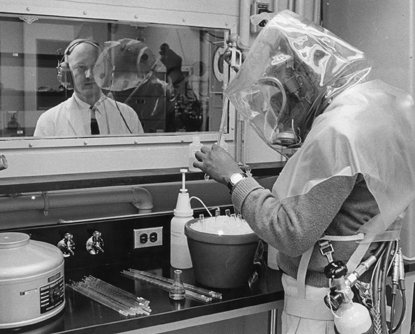
COURTESY OF NIH OFFICE OF HISTORY
This oxygen-free, steel-framed box was the first of its kind to be used for biomedical research. Built in 1967 for $250,000, NIH’s anaerobic laboratory was primarily used by Earl and Thressa Stadtman’s groups to work with certain enzymes and other biological compounds that are inactivated when exposed to oxygen. The room was filled with a mixture of nitrogen and hydrogen and contained a variety of instruments. Anyone working in the room had to wear a special mask fitted with an air-delivery tube and be continually monitored—both visually and via a two-way communication system—by someone who sat outside the room.
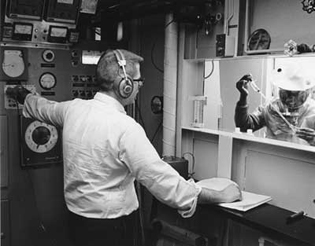
Despite all the precautions, there were times when the mask failed or didn’t fit properly. “The first time we used [the oxygen mask], we had a long, skinny-faced fellow who put it on,” recalled former NHLBI scientist Michael Poston. “He was getting a little woozy.” The Stadtmans eventually installed an oxygen monitor to guard against this sort of problem, but not before at least one man nearly passed out.
Building 3 Luminaries
MENTIONED IN THE ARTICLE:
- Christian Anfinsen received the 1972 Nobel Prize in Chemistry for “for his work on ribonuclease, especially concerning the connection between the amino acid sequence and the biologically active conformation.”
- Julius Axelrod was awarded the 1970 Nobel Prize in Physiology or Medicine for his work on catecholamine neurotransmitters.
- Robert Berliner was an eminent renal physiologist.
- Robert Bowman invented the practical spectrophotofluorometer, used to measure tiny amounts of substances in the body.
- Nina Braunwald was the first woman to be board certified as a cardiac surgeon.
- Bernard B. Brodie was an internationally renowned pharmacologist who was involved in the development of acetaminophen (with Julius Axelrod before coming to NIH) and won a Lasker Award in 1967 for his contributions to biochemical pharmacology.
- Michael Brown shared the 1985 Nobel Prize in Physiology or Medicine for discovery of mechanisms regulating cholesterol metabolism.
- G. Robert Coatney was a malaria researcher who identified the malaria parasite in birds.
- Nathan B. Eddy helped to spearhead the field of drug dependence.
- Donald S. Fredrickson served as NIH director (1966 to 1974) and was elected to the National Academy of Sciences for his accomplishments in lipid research.
- Leon Heppel was one of first to investigate enzymes that modify RNA.
- Bernard Horecker discovered key enzymes and phosphates in the pentose phosphate pathway, which is important for the synthesis of amino and fatty acids.
- Edward Korn made landmark discoveries about two of the proteins responsible for cell movement, actin and myosin.
- Arthur Kornberg was the 1959 Nobel laureate in Physiology or Medicine for being the first (along with Severa Ochoa) to synthesize DNA.
- Stanley Prusiner received the 1997 Nobel Prize in Physiology or Medicine for the discovery of prions, a new biological principle of infection.
- James A. Shannon was the National Heart Institute’s first scientific director, NIH’s first director of intramural research, and later served as NIH director (1955 to 1968).
- Thressa and Earl Stadtman were outstanding biochemists and mentors who dedicated their careers to research at NIH. Thressa’s studies of anaerobic metabolism systems led to the discovery of five vitamin B12–dependent enzymes. She also pioneered the field of selenium biochemistry. Earl helped to establish the role of coenzyme A in the synthesis of fatty acids, identified mechanisms for controlling the production of amino acids, and investigated protein damage in relation to aging.
- Sidney Udenfriend became the founding director of the Roche Institute of Molecular Biology in Nutley, N.J. (1967 to 1983).
- Roy Vagelos became chief executive officer Merck Pharmaceuticals (1985 to 1986).
- Martha Vaughan performed groundbreaking work on the role of cyclic nucleotides and G-proteins in regulating lipolysis in fat cells (married to Jack Orloff).
- James Wyngaarden served as NIH Director (1982 to 1989).
OTHER BUILDING 3 LUMINARIES
- Eugene Braunwald, who had a lab in Building 3 during the 1960s, was a renowned cardiologist whose work has expanded the knowledge of heart diseases in the areas of congestive heart failure, coronary heart disease, and valvular heart disease.
- James Ferretti, a leader in the application of pulsed Fourier-transform nuclear magnetic resonance techniques to the study of medically important chemical and biological systems, did this work in Building 3 during the 1990s.
- Evan Horning, a pioneer of modern biochemical analysis techniques, was chief of NIAMD’s Laboratory of the Chemistry of Natural Products in Building 3 during the early 1950s.
- Herman Kalckar was a pioneer in the study of cellular respiration; he worked in Building 3 in the early 1950s.
- Edward S. Josephson was a pioneer in developing radiation sterilization of food; he worked on treatments against malaria and other tropical diseases in Building 3 during the 1940s and 1950s.
- Jack Orloff worked in Building 3 in the early 1950s and served as NHLBI’s scientific director from 1974 to 1988 (married to Martha Vaughan).
- Sue Goo Rhee, a former Stadtman postdoc, was head of the Laboratory of Cell Signaling when it was moved to Building 50 in 2001. While working in Building 3, he made major contributions to the understanding of cell signaling by enzymes, the phospholipases, and discovered a new class of signaling enzymes, now called peroxiredoxins.
- Nathan Shock, a noted gerontologist and first scientific director of NIA, had an office in Building 3 in the 1950s.
- Luther Terry, who had an office in Building 3 as NHLBI’s chief of General Medicine and Experimental Therapeutics in the early 1950s, served as U.S. Surgeon General (1961 to 1965).
- Bernhard Witkop discovered the “NIH shift,” a phenomenon in organic chemistry, and helped form the NIH Visiting Fellows Program; he was in Building 3 in the early 1950s.
Many thanks to all who helped with the article on the history of Building 3: Edward Korn, Alan Schechter, NIH Office of History (Barbara Harkins, Hank Grasso, Victoria Harden, Michele Lyons), Eugene Braunwald, Dexroy Chism, Rodney Levine, Buhm Soon Park, Michael Poston, Herbert Tabor, Martha Vaughan, the NIH Record and others.
MORE PHOTOS
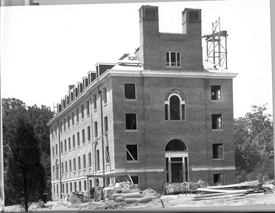
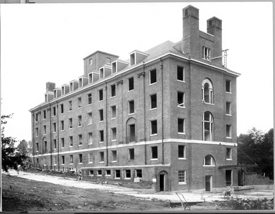
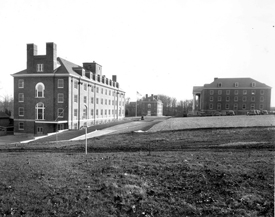
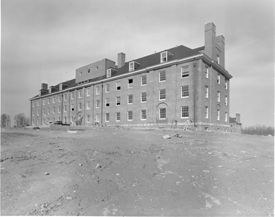
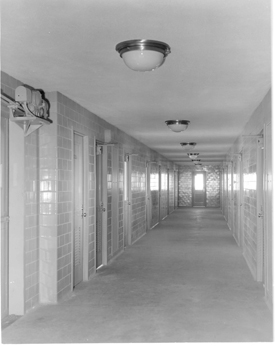
This page was last updated on Friday, April 29, 2022
